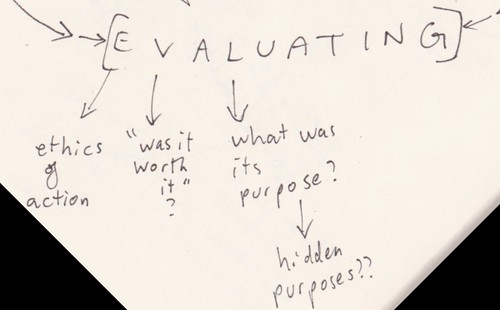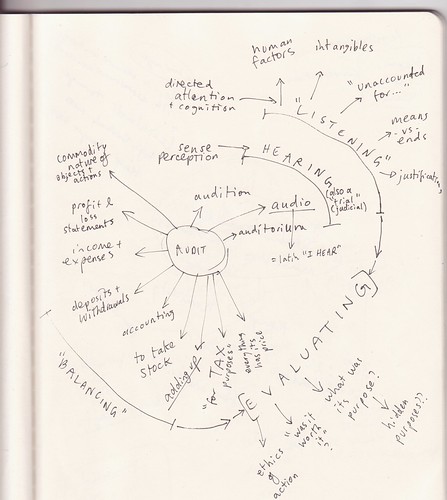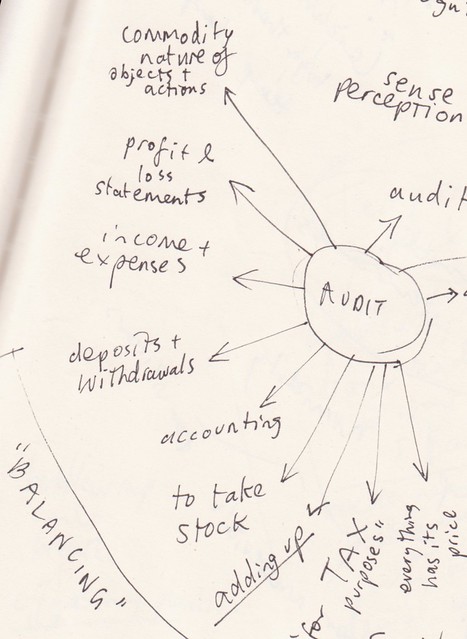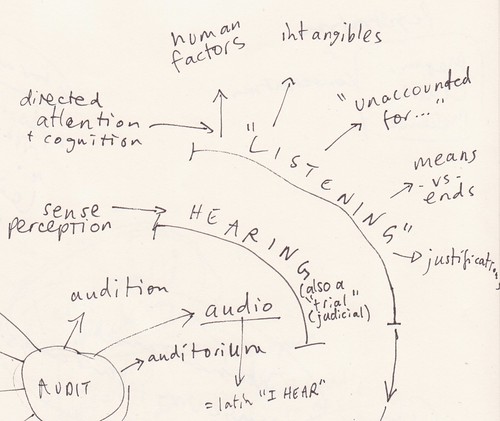My job, until the end of October, is to carry out an Environmental Audit on the MCA’s exhibition In the Balance: Art for a Changing World.
Being that kind of guy who likes to start from the beginning, my first task, I reckon, is to tackle the thorny question:
“What is an audit?”
Yesterday on the train to from Petersham to the MCA, without having done any prior research on the subject, I drafted up the above diagram.
I wanted to see what might emerge from my own foggy brainstock before discovering (and possibly being rather daunted by) what a “proper” audit might be.
At the left hand side of the diagram, you have my unsubstantiated common-sense definition of an audit:
In a nutshell, here’s what I figure:
The fact that we as humans like to trade with each other means that objects and activities have become “commodified”. These objects or activities have relative values attributed to them, which we represent in an abstract numerical way, as dollars. We can tally up all the numerical values which slosh around through trade, in order to find out their overall balance.
For example, the flow of numbers into my own bank account, and their flow out of the same bank account, can be checked against each other in order to work out whether I’ve made a profit or loss in a given time period.
That’s the process I go through each year with my accountant, and it helps the government to determine how much tax I should pay.
Every so often, the Tax Office might want to check up on me, so they’ll “do an audit”, making sure me and my accountant are adding things up legally. (Thankfully this has never happened to me personally, but I remember a few years ago my friend Sue (an artist) got audited by the ATO, and it was a rather harrowing experience for her. She had to lay bare her entire paper trail of activities – not an easy thing for an artist to do…)
I guess one of the issues that auditors have to deal with is that some transactions (cash sales, swaps, gifts and so on) don’t pass through our bank accounts – they slip by without a trace, and so exist “beyond the auditable”.
Anyway… leaving that part of the diagram for the moment…
On the right hand side of the diagram, I noticed that the word “audit” sounded a bit like “audition” or “auditorium” or “audio”.
I figured that “aud-” might have something to do with hearing.
(“A hearing” is also the name for a legal trial, which sounded kinda right, in terms of the desire an audit has to judge the correct balance of things. )
Scribbling away furiously as I passed through Wynyard Station, I then expanded hearing (which is a form of sense perception) to listening, which is a more directed and attentive way of hearing.
I figured that one of the things that an auditor does is to listen carefully to all the circumstances in order to weigh up the situation.
This realisation made me happy. I’m not very good at tallying up numbers, but listening is one of the things I am not bad at.
Listening, I think, should be able to take into consideration a bunch of intangible human factors: justifications for actions which don’t seem very rational, ways we feel about our activities. These things are normally “unaccountable”. This is the stuff that falls outside of what your bona-fide auditor could tally up.

Making sense of the gulf between the stuff which is accountable and the stuff that is unaccountable. I reckon that’s my job.




I just found this while searching the internet for inspiration as I’m trying to develop an audit for stuff that is mostly in that ‘gulf between accountable and unaccountable’ – your perspective has given me lots to think about – thanks.
fantastic Rachel. I love that territory – you must pass along your own discoveries if you feel they are “articulable”!